I’ve been sick and without a voice for a few weeks and have been sitting in long stretches of stillness and silence at home. The kind of unexpected, enforced quietness and simplicity that reminded me of the first lockdown in Germany at the start of the pandemic. And the same thing emerged, the same source of comfort appeared in these last weeks as in the early pandemic: a slowing down and a kind of attention to the curation and the ritual of that most quotidian thing – nourishing oneself through food.
Melanie Goodchild, in her conversation with Thomas Huebl and Otto Sharmer in the 2022 Collective Trauma summit talks about the importance of: “creating or elevating daily practices to a ritual or to a ceremony”.
Goodchild is Anishinaabe (Ojibway), moose clan, from Biigtigong Nishnaabeg and Ketetgaunseebee First Nations. She is a systems and complexity scholar using a relational systems thinking approach at the nexus of multiple worldviews. In the context of a conversation about the urgency of sensing into systems, into the systems we’re living in to help us create a new world, she was talking about slowing down and using an old technology: sharing food together. Practicing simple, powerful rituals around food through which we create new, healthier connections between ourselves and each other and between ourselves and the world.
“we forget when we're buying our food and what we're eating and how quickly we're eating it, that all of that does connect us to Mother Earth. And doing that together, preparing meals together and sitting together, slowing down, I think, is a huge part of that. And so when I slow down the preparation of our morning tea and when my husband did that and he was pouring the water over a teapot and I would see the steam coming up. In that moment, it was so healing for me to see that [...]
And I think the elevation of our morning tea to a ceremony is really significant, because people are looking for something really big sometimes like a four day fast or some of our other ceremonies that go on for a long time. And the process of doing that collectively, it was myself, my mother—who is an elder—and my husband, the three of us throughout COVID.”
My partner and I take such a moment at breakfast-time which has become a regular ritual since the pandemic began. We create a breakfast board, a laying out of the fruit that will soon go into the porridge. It doesn’t take so long but it takes long enough to slow us down to the pace of the body. It becomes a celebration of the season, of the fruit that’s available. It’s the ritual that tunes us when we’re together and connects us when we’re in different places – a kind of contract of accountability that we’re both, at least, eating a good breakfast. Importantly for us, it’s a first act of creation – an important practice for artists but also just an important practice for humans.

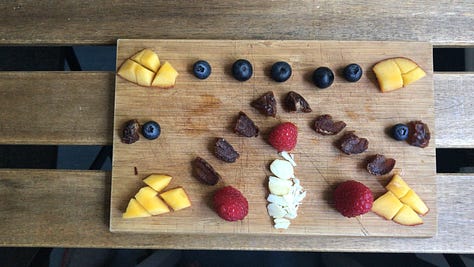
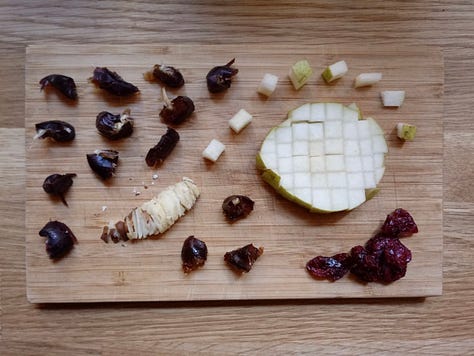
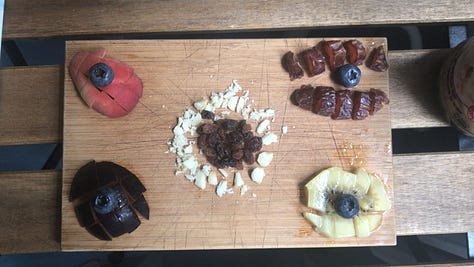
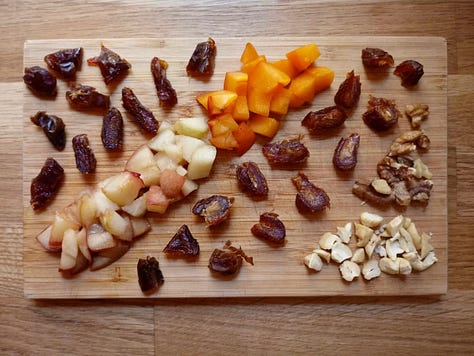
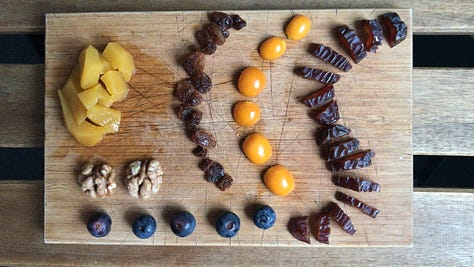


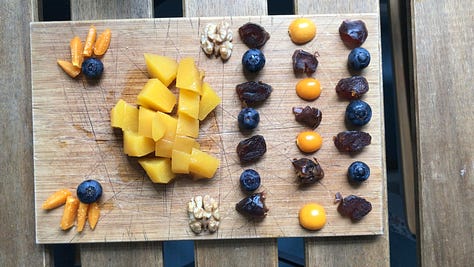
I realise that most creative processes and events I’ve been a part of have involved food. In the last process, also with my breakfast-board collaborator – the solo-dance piece If the bull won’t come – we had many moments of insight and important deepening connection over food. I have a feeling that I could boil creative processes down to these two things: a set of practices that allow you to open the particular space and world of that piece; and cultivating relationships. Without these there is no work of creation, nothing can come through. And what better way to cultivate relationships that over a meal or a coffee or tea. The team of If the bull won’t come have spent many wonderful hours unfolding the process and deepening the connections with each other in the kitchen of fabrik Potsdam, through spontaneous dinners with members of the team, coffees that clarified the next focus in the work or gave us the title of the piece, evenings of preparing together each other’s favourite dishes or foods from home. Practicing living well together, as Donna Haraway might say.
What are your rituals around food? What are your practices around creation?
I’d love to hear from you in the comments!
How delightful then, in my last Chinese calligraphy class, to learn that one character we were working with huì (in the pinyin) which means “meeting”, has a very special etymology.
Chinese calligraphy has developed since c. 1200BCE through five main styles of script – drafting script, cursive script, regular script, clerical script, going back all the way to seal script or oracle script. The origins of Chinese characters are ideograms. As David Abram explains in his wonderful book The Spell of the Sensuous, an ideogram is:
“a pictorial character that refers not to the visible entity that it explicitly pictures but to some quality or other phenomenon readily associated with that entity. Thus – to invent a simple example – a stylized image of a jaguar with its feet off the ground might come to signify “speed”. For the Chinese, even today, a stylized image of the sun and moon together signifies “brightness”; similarly, the word for “east” is invoked by a stylized image of the sun rising behind a tree.”
So huì evokes something more visible, visceral and human as it displays and explains “meeting”.
If we look at its development in reverse, here it is in more modern regular script
会
As you go back you arrive here
會
㑹
And if we break this 㑹down into different parts, we get the word for mouth (upside-down) which is 亼 jí and 曰 yuē which is mouth-speaking. Then rem- 𡆧 from field 田 tián from rice 米 or, if we put it together another way - mouths talking 合 about the fields 田 or about rice 米
Or, as my calligraphy teacher said, going right back to the first iteration of the word in seal script: doesn’t the seal script character look like a rice steamer? With a top and a bottom and rice in the middle?


Why meet, why come together just to talk about rice, when you could also eat some together?!
And so, we’re approaching our next RE.MEMBERING session this Sunday 12th March at the wonderful LAKE Studios, Berlin and here there is no exception: after the three hours of training comes a lunch break to meet, talk and eat with one another. Cake and fruit will be provided. Bring some tea and your own tea cup! More info in the link above.
I look forward to meeting you there.
Cat
And I can’t quite finish this post without recommending two things:
1. Pádraig Ó’Tuama’s brilliant post here on Substack with a soup recipe (I haven’t tried it yet but am nourished enough just by his instructions. Also, all his posts are wonderful. I recommend them. Also I will try the soup). Back to the instructions:
“Once the onions smell like you want to eat them there and then, add in some freshly torn garden herbs (or dried if they’re easier). Whatever you like: I like thyme, marjoram, and sage. Stir it around until your brain starts to buzz a little with the aroma. Then add in most (not all) of the roast garlic. Take a whiff of the goodness and recite Emily Dickinson’s “Because I could not stop for Death” to yourself.”
Find him here at:
And
2. The Truffle Hunters – a quirky, heart-warming, beautifully shot documentary about a group of eccentric truffle hunters from the Piedmont region of Italy. A dazzling glimpse into the community and characters and how they come together around the incredibly-sought-after Alba Tartufi, the alba (white) truffle. For when you need something restorative.
Trailer here:
& here Aurelio Conterno and his beloved Birba:




